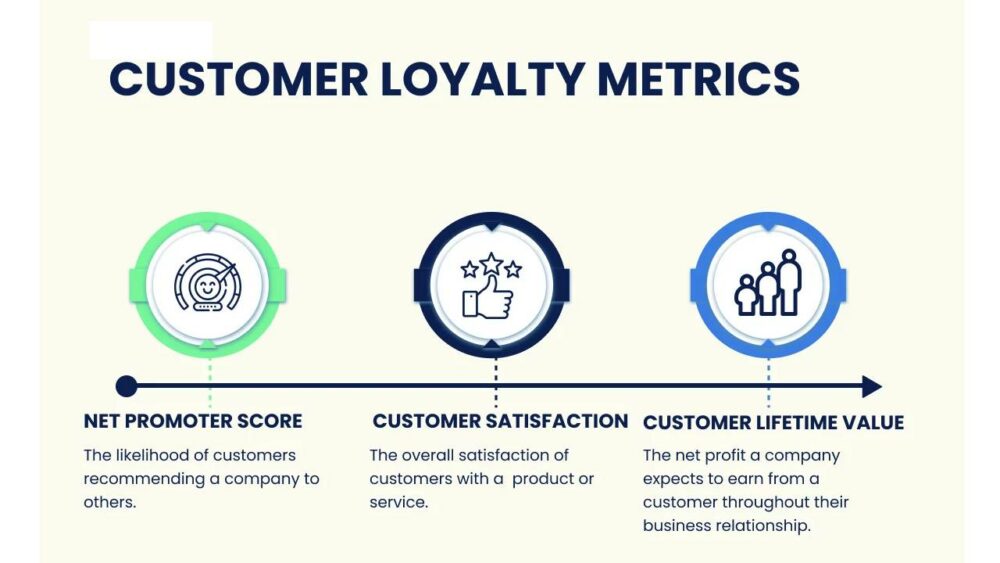Welcome to the universe of business dominance, where the way to opening achievement lies in understanding and bridling the force of Client Reliability Measurements.
In this time of tireless contest, each business points to flourish as well as to prosper. That’s where Customer Loyalty Metrics come into play as the compass guiding your journey. These measurements are not simply numbers; they are the heartbeat of your client connections.
In this article, we will dive into the meaning of Client Devotion Measurements and investigate why following them matters like never before. We should leave this illuminating excursion to translate the insider facts behind business development, each measurement in turn.
Understanding Customer Loyalty Metrics
Exploring the realm of business metrics may seem like a daunting task, but understanding Customer Loyalty Metrics is akin to unlocking the secrets of a treasure chest. These metrics are the guiding stars that steer businesses toward success.
In this part, we’ll set out on an excursion to disentangle the universe of Client Unwaveringness Measurements, separating complex ideas into effectively edible pieces.
We’ll begin by characterizing what Client Devotion Measurements are and afterward dive into the different kinds, for example, Client Standard for dependability, Net Advertiser Score (NPS), Client Lifetime Worth (CLV), Stir Rate, and Rehash Buy Rate.
En route, we’ll find the significant connection between these measurements and the productivity of your business, revealing insight into how each piece of the riddle adds to your general achievement.
Defining Customer Loyalty Metrics:
Client Steadfastness Measurements, as the name recommends, are the quantifiable marks of how faithful and drawn in your clients are with your image and items.
Types of Customer Loyalty Metrics:
These metrics come in various forms, each providing unique insights into your customer relationships.
- Customer Retention Rate: This metric gauges how effectively your business retains customers over a specific period.
- Net Promoter Score (NPS): NPS measures the likelihood of customers recommending your business to others.
- Customer Lifetime Value (CLV): CLV works out the normal income a client is supposed to produce through their whole relationship with your business.
- Churn Rate: The Churn Rate demonstrates the level of clients who quit utilizing your items or administrations during a given period.
- Repeat Purchase Rate: This metric shows how often customers return to make additional purchases.
See Also: Five Tips for Good Customer Loyalty
The Link Between Customer Loyalty and Profitability:
The link between customer loyalty and profitability is the golden thread that weaves its way through the fabric of successful businesses. When customers feel a deep sense of loyalty, they become more than one-time buyers; they become brand advocates.
These loyal customers not only make repeat purchases but also spread positive word-of-mouth, attracting new customers. This ripple effect leads to increased revenue, reduced customer acquisition costs, and higher customer lifetime value.
By tracking customer loyalty metrics effectively, businesses can identify and nurture these valuable relationships, creating a sustainable path to profitability and long-term growth. In essence, customer loyalty metrics serve as the compass guiding businesses toward a more prosperous future.
Setting the Foundation: Choosing the Right Metrics
Choosing the right path is essential when it comes to navigating the world of customer loyalty metrics. Just as a navigator selects the best route to reach their destination, businesses must set a solid foundation by selecting the most appropriate metrics. In this section, we’ll explore the critical steps involved in this journey.
We’ll begin by identifying your unique business goals, a crucial compass that guides your metric selection process. Then, we’ll delve into the art of selecting relevant metrics that align perfectly with your objectives. Lastly, we’ll discuss the importance of customizing metrics to suit the specific nuances of your industry.
So, let’s embark on this voyage of metric selection, where every decision you make will steer you toward business success.
Identifying Your Business Goals:
Before you can choose the right customer loyalty metrics, it’s vital to have a clear understanding of your business goals and what you want to achieve.
Selecting Relevant Metrics:
Once your goals are established, it’s time to pinpoint the metrics that will help you measure progress toward those goals most effectively.
Customizing Metrics for Your Industry:
Every industry has its unique characteristics and challenges. Tailoring your metrics to suit your industry’s specific needs is key to obtaining actionable insights.
Measuring Customer Loyalty Effectively
Measuring customer loyalty effectively is akin to crafting a finely tuned instrument that harmonizes your business efforts with customer satisfaction. In this section, we will embark on a journey of discovery to understand the crucial components of measuring customer loyalty metrics with precision.
We’ll begin with the art of data collection and analysis, emphasizing the importance of accurate and timely data. Then, we’ll explore the various tools and software available for tracking these metrics efficiently.
Customer surveys will also take the spotlight, revealing their role in gaining valuable insights from the very source—your customers. Finally, we’ll delve into the transformative power of leveraging big data and artificial intelligence (AI) in the quest for more profound customer loyalty understanding and strategic decision-making.
Data Collection and Analysis:
The foundation of effective customer loyalty metric measurement lies in the systematic collection and insightful analysis of relevant data.
Tools and Software for Metrics Tracking:
Tools and software for metrics tracking are the foundation upon which businesses build their understanding of customer loyalty. In the advanced age, a variety of refined apparatuses and programming arrangements are accessible to gather, break down, and decipher client dedication measurements.
With the right instruments available to them, organizations can follow progress, recognize patterns, and pursue informed choices that drive consumer loyalty and eventually cultivate business development through superior client dedication measurements.
The Role of Customer Surveys:
The role of customer surveys in the realm of customer loyalty metrics is paramount. Surveys act as a direct line of communication between businesses and their customers, providing a valuable channel for feedback and insights.
By crafting well-designed surveys, businesses can gauge customer satisfaction, identify pain points, and understand specific preferences. These insights, in turn, inform strategic decisions aimed at enhancing the customer experience and fostering loyalty.
Customer surveys serve as the compass guiding businesses toward data-driven improvements and the cultivation of lasting customer relationships. They are an invaluable tool in the pursuit of not only understanding customer sentiment but also propelling business growth through the optimization of loyalty metrics.
Leveraging Big Data and AI:
Utilizing huge information and computerized reasoning (man-made intelligence) is an extraordinary power in the realm of client reliability measurements and business development. Enormous information empowers organizations to gather and handle immense measures of client data, revealing secret examples and patterns.
Computer-based intelligence, then again, can examine this information with noteworthy speed and accuracy, giving prescient experiences into client conduct and inclinations. Together, they empower businesses to personalize customer experiences, target marketing efforts effectively, and predict customer needs.
By harnessing these advanced technologies, businesses can elevate their understanding of customer loyalty metrics, make data-driven decisions, and create strategies that not only retain customers but also drive sustainable business growth.
Interpreting and Applying Customer Loyalty Metrics
Understanding customer loyalty metrics is just the beginning; the real magic happens when we interpret and apply these metrics to drive business growth and customer satisfaction. In this section, we will explore the art of decoding customer loyalty metrics and unlocking their true potential.
We’ll begin by talking about the significance of benchmarking your measurements and assisting you with checking your presentation against industry guidelines. Then, we’ll dig into recognizing qualities and shortcomings inside your measurements, empowering you to pinpoint regions for development.
Then, we’ll explore the essential step of creating actionable insights that can guide your strategic decisions. Lastly, we’ll emphasize the power of making data-driven decisions, where the numbers guide your path toward greater customer loyalty and business success.
Benchmarking Your Metrics:
Benchmarking your metrics involves comparing your customer loyalty data against industry standards and competitors. This practice provides essential context, helping businesses identify areas of strength and areas that need improvement. It’s a significant stage in the excursion to upgrade client devotion measurements and drive business development.
Identifying Strengths and Weaknesses:
Distinguishing qualities and shortcomings in client dedication measurements are fundamental for informed navigation. It involves assessing where your business excels and where it falls short in fostering customer loyalty. Recognizing these aspects helps you fine-tune strategies and drive improvements for sustainable business growth.
Creating Actionable Insights:
Creating actionable insights from customer loyalty metrics involves translating data into practical steps for improvement. It’s the process of extracting valuable information and turning it into strategies that drive positive changes in customer loyalty. These insights empower businesses to make informed decisions and enhance customer satisfaction, fueling growth.
Making Data-Driven Decisions:
Making data-driven decisions in customer loyalty metrics is the cornerstone of effective strategy. By relying on concrete data rather than intuition, businesses can steer their actions toward fostering loyalty and driving growth. It ensures that every decision aligns intending to optimize customer loyalty metrics and achieve business success.
Improving Customer Loyalty Metrics
Elevating your customer loyalty metrics is a journey toward lasting success in the world of business. In this section, we’ll embark on a voyage of improvement, exploring strategies that can propel your customer loyalty metrics to new heights.
We’ll delve into the art of increasing customer retention, where every retained customer becomes a loyal advocate. Enhancing the customer experience will take center stage, highlighting its pivotal role in fostering loyalty.
We’ll also uncover the magic of personalization and customer engagement, revealing how connecting with customers on a personal level can yield remarkable results. Lastly, we’ll explore the implementation of loyalty programs, a tried-and-true method for cultivating loyalty in the hearts of your customers.
Strategies for Increasing Retention:
Strategies for increasing retention are pivotal in the pursuit of improving customer loyalty metrics. These tactics focus on nurturing existing customer relationships, encouraging repeat business, and reducing churn. Effective retention strategies create a loyal customer base, a cornerstone for sustainable business growth through enhanced loyalty metrics.
Enhancing Customer Experience:
Enhancing the customer experience is a linchpin in improving customer loyalty metrics. It involves delivering exceptional service, personalized interactions, and seamless journeys that leave customers satisfied and loyal. A positive customer experience not only boosts loyalty metrics but also fosters business growth through delighted and returning customers.
Personalization and Customer Engagement:
Personalization and customer engagement are powerful tools for improving customer loyalty metrics. By tailoring interactions, messages, and offers to individual preferences, businesses foster deeper connections with customers.
Personalized experiences engage customers, fostering loyalty and driving business growth through meaningful, enduring relationships.
Implementing Loyalty Programs:
Implementing loyalty programs is a proven method for improving customer loyalty metrics. These programs incentivize repeat business, reward customer loyalty, and ultimately contribute to business growth by cultivating enduring customer relationships.
Avoiding Common Pitfalls
In the pursuit of mastering customer loyalty metrics, it’s essential to navigate carefully and avoid common pitfalls that can derail your efforts. This section will serve as your compass, guiding you away from potential mistakes.
In the first place, we’ll investigate the frequently disregarded domain of subjective measurements, revealing insight into their importance past the numbers. Then, we’ll underline the significance of the human component, advising us that behind each datum point is a person with remarkable necessities and inclinations.
At last, we’ll pressure the basic job of input and client feeling, highlighting the force of paying attention to your clients’ voices to calibrate your procedures.
Overlooking Qualitative Metrics:
Beyond the quantitative data, qualitative metrics provide invaluable insights into the emotions, motivations, and perceptions of your customers, offering a more holistic view of loyalty.
Neglecting the Human Element:
In the world of customer loyalty metrics, it’s crucial to remember that every data point represents a real person with feelings, desires, and expectations. Neglecting the human element can lead to missed opportunities for genuine connection and loyalty.
Ignoring Feedback and Customer Sentiment:
Your customers hold the key to unlocking improved loyalty metrics. By actively seeking and acting upon customer feedback and sentiment, you can address concerns, make meaningful improvements, and demonstrate your commitment to their satisfaction.
Future Trends in Customer Loyalty Metrics
The horizon of customer loyalty metrics is ever-changing, shaped by the winds of technological advancement and shifting customer expectations.
In this section, we’ll gaze into the crystal ball and explore the fascinating future trends that will redefine the landscape of loyalty measurement.
To start with, we’ll explore the crucial job of arising innovations, which are set to change how we track and decipher client dependability. Then, at that point, we’ll dive into the domain of prescient examination and man-made brainpower (computer-based intelligence), uncovering how these state-of-the-art devices will raise reliability estimation higher than ever.
Ultimately, we’ll consider the developing scene of client assumptions, a main impetus that will keep on forming the fate of client steadfastness measurements.
The Role of Emerging Technologies:
As emerging technologies like blockchain, augmented reality, and the Internet of Things (IoT) become more integrated into daily life, they will play an increasingly significant role in shaping the way businesses measure and enhance customer loyalty.
Predictive Analytics and AI in Loyalty Measurement:
Predictive analytics and AI-driven solutions will transform loyalty measurement from a historical analysis to a forward-looking strategy, enabling businesses to predict customer behavior and proactively nurture loyalty.
The Evolving Customer Expectations:
In an era of rapid technological advancement and changing consumer behavior, customer expectations are evolving. Understanding and adapting to these evolving expectations will be essential for businesses to maintain and grow customer loyalty metrics.
Conclusion
In conclusion, our journey through the realm of customer loyalty metrics has unveiled a treasure trove of insights and strategies. As we recap our key takeaways, remember that customer loyalty metrics are not mere numbers; they are the compass guiding your path to business growth. Emphasizing their value can transform your business from ordinary to extraordinary, fostering enduring relationships with your customers.
So, what’s your next step in mastering loyalty metrics? It’s time to put this knowledge into action, implement these strategies, and watch your business flourish. Your success story begins now.
We invite you to share your thoughts and feedback in the comments below and, most importantly, to share this invaluable information with your friends and colleagues. Together, let’s unlock the door to success through customer loyalty metrics.








